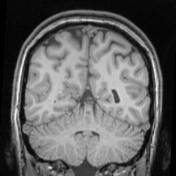Brain signals revive paralyzed muscles in monkeys
 NEW YORK (AP) -- Monkeys taught to play a computer game were able to overcome wrist paralysis with an experimental device that might lead to new treatments for patients with stroke and spinal cord injury.
NEW YORK (AP) -- Monkeys taught to play a computer game were able to overcome wrist paralysis with an experimental device that might lead to new treatments for patients with stroke and spinal cord injury.Remarkably, the monkeys regained use of paralyzed muscles by learning to control the activity of just a single brain cell.
The result is "an important step forward," said Dawn Taylor of Case Western Reserve University in Cleveland, who studies the concept of using brain signals to overcome paralysis. She wasn't involved in the new work.
The device monitored the activity of a brain cell and used that as a cue to stimulate wrist muscles electrically. Researchers found it could even use brain cells that normally had nothing to do with wrist movement, said study co-author Chet Moritz.
So a large untapped pool of brain cells may be available for letting paralyzed people do things like grasping a coffee cup or brushing teeth, Moritz said. But he stressed the approach is years, if not decades, away from use in people.
Moritz and his colleagues at the University of Washington in Seattle report the results in a paper published online Wednesday by the journal Nature.
Taylor, who also works with the Cleveland VA Medical Center, said the study illustrates the potential of the approach and the flexibility of brain cells.
Lee Miller, a researcher at Northwestern University who has done similar work, said any demonstration of a device using brain signals to make paralyzed limbs move is "an important new development."
Miller used the pattern of activity in about 100 brain cells to predict the kind of wrist movement a monkey wanted to make. Moritz said focusing on the output of an individual brain cell instead may turn out to work better for overcoming paralysis.
The research is an example of what scientists call functional electrical stimulation, or FES, which involves stimulating muscles by applying electrical current. Partially paralyzed people use FES devices now to let them stand, walk, use their arms and hands, and do other things. But they control those devices by flicking a switch, moving joints or tensing a muscle - even, say, the muscle that enables them to wiggle an ear.
Taylor said using brain signals instead could be a particularly good strategy for people paralyzed from the neck down who have few available muscles that they can control.
In the monkey study, scientists tested two pigtail macaques at different times. Each had a hand placed on a flat surface. The animals learned that by using their wrists to press downward with their palms or upward with the backs of their hands, they could make a computer cursor reach a target on a screen. Then researchers temporarily paralyzed their wrists with an anesthetic.
Scientists had put a probe in the animals' brains that monitored how often a single brain cell was firing electrical signals. Once the wrists were paralyzed, that firing rate was converted into an electrical stimulation that went to the wrist muscles.
Different firing rates made the hand press downward or upward, or relax. The monkeys quickly learned to use the brain cells to control their wrist muscles and continue playing the computer game.
In people, more complex movements would require monitoring many brain cells at once to activate multiple muscles, Moritz said. Researchers would rely on the brain to learn how to coordinate all these signals to produce a useful motion, he said. After all, that's what the brain does when a person learns to swing a tennis racket effectively, he said.
"There's a long ways to go, and there's no way to say with confidence that it will work," Moritz said.
It's also possible that a single brain cell could stimulate a group of muscles, if its signals are relayed to particular sites in the spinal cord, researchers said.
Andrew Schwartz of the University of Pittsburgh, who has used brain signals to enable monkeys to control robot arms, said he considered the new work a modest advance, noting hurdles that remain.
---
On the Net:
Nature: http://www.nature.com/nature
![Reblog this post [with Zemanta]](http://img.zemanta.com/reblog_e.png?x-id=98749af4-1542-4a80-a1ec-f5047dfa938e)

Comments